1996 PONTIAC GRAND-AM ESP
[x] Cancel search: ESPPage 161 of 356
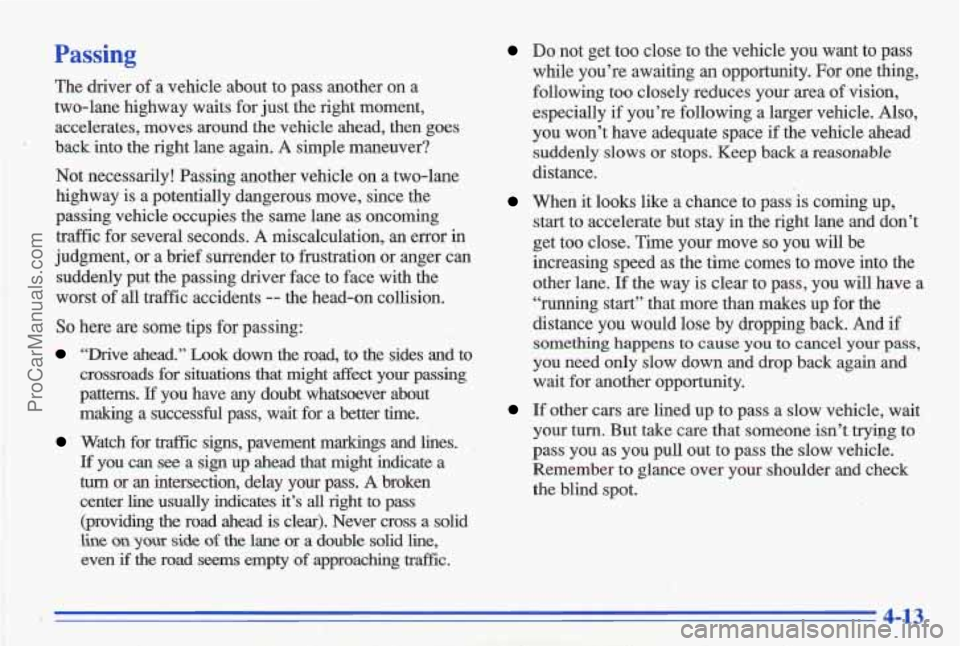
Passing
The driver of a vehicle about to pass another on a
two-lane highway waits for just the right moment,
accelerates, moves around thle vehicle ahead, then goes
” back into the right lane again. A simple maneuver?
Not necessarily! Passing another vehicle on a two-lane
highway is a potentially dangerous move, since the
passing vehicle occupies the same lane a5 oncoming
traffic for several seconds.
A miscalculation, an error in
judgment, or
a brief surrender to frustration or anger can
suddenly put the passing driver face to face with the
worst of all traffic accidents
-- the head-on collision.
So here are some tips for passing:
“Drive ahead.” Look down the road, to the sides and to
crossroads for situations that might affect your passing
patterns.
If you have any doubt whatsoever about
making .a successful pass, wait for a better time.
Watch for traffic signs, pavement markings and lines.
Lf you can see a sign up ahead that might indicate a
turn or an intersection, delay your pass. A broken
center line usually indicates it’s
all right to pass
(providing
the road ahead is clear). Never cross a solid
line on yous side of the lane or a double solid line,
even if the road seems empty of approaching traffic.
i( . . ’.-, . .‘ d“. . .. . * ,) .: ’ ;
Do not get too close to the vehicle you want to pass
while you’re awaiting
an opportunity. For one thing,
following too closely reduces your area of vision,
especially
if you’re following a larger vehicle. Also,
you won’t have adequate space
if the vehicle ahead
suddenly slows or stops. Keep back a reasonable
distance.
When it looks like a chance to pass is coming up,
start to accelerate but stay in the right lane and don’t
get too close. Time you move
so you will be
increasing speed as the
time comes to move into the
other lane.
If the way is clear to pass, you will have a
“running start” that more than makes up for the
distance
you would lose by dropping back. And if
something happens to cause you to cancel your pass,
you need only slow down and drop back again and
wait for another opportunity.
If other cars are lined up to pass a slow vehicle, wait
your turn. But take care that someone isn’t tryigg to
pass you as you pull out to pass the slow vehicle.
Remember to glance over your shoulder and check
the blind spot.
4-13
ProCarManuals.com
Page 162 of 356
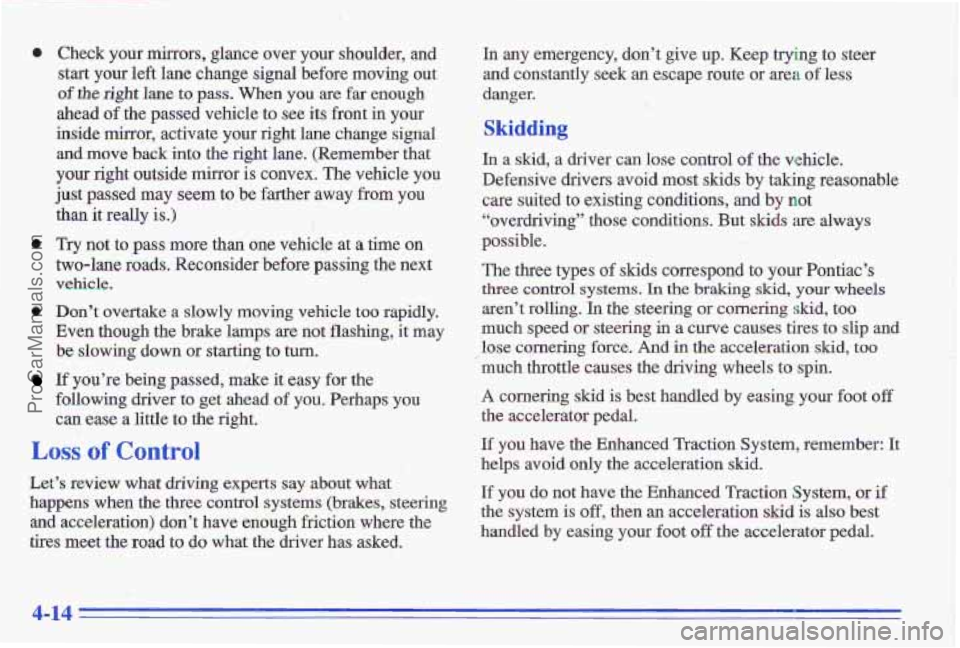
0
0
a
Check your mirrors, glance over your shoulder, and start your left lane change signal before moving out
of the right lane to pass. When you are far enough
ahead
of the passed vehicle to see its front in your
inside mirror, activate your right lane change signal and move back into the right lane. (Remember that
your right outside mirror
is convex. The vehicle you
just passed may seem
to be farther away from you
than it redly is.)
Try not to pass more than one vehicle at a time on
two-lane roads. Reconsider
before passing the next
vehicle.
Don’t overtake a slowly moving vehicle too rapidly.
Even though the brake lamps are not flashing, it may
be slowing down or starting to turn.
If you’re being passed, make it easy for the
following driver to get ahead of you. Perhaps you
can ease a little to the right.
In any emergency, don’t give up. Keep trying to steer
and constantly seek
an escape route or area of less
danger.
Skidding
In a skid, a driver can lose control of the vehicle.
Defensive drivers avoid most skids by
taking reasonable
care suited
to existing conditions, and by not
“overdriving” those conditions. But skids are always
possible.
The three types
of skids correspond to your Pontiac’s
three control systems. In the braking skid, your wheels
aren’t rolling. In the steering or cornering skid, too
much speed or steeiing
in a curve causes tires to slip and
lose cornering force. And
in the acceleration skid, too
much throttle causes the driving wheels to spin.
A cornering
skid is best handled by easing your foot off
the accelerator pedal.
If you have the Enhanced Traction System, remember: It
helps avoid only the acceleration skid.
If you do not have the Enhanced Traction System, or if
the system is off, then an acceleration skid is also best
handled by easing your foot
off the accelerator pedal.
Loss of Control
Let’s review what driving experts say about what
happens
when the three control systems (brakes, steering
and acceleration) don’t have enough friction where the
tires meet the road to do what the driver has asked.
4-14
ProCarManuals.com
Page 164 of 356

Here are some tips on night driving.
Drive defensively.
Don't drink and drive.
Adjust yous inside rearview mirror to reduce the
. ,.* . - !:?<: -. ' ' ,- 1. /. . I .%d. .:,fi$;
,.
..
glare from headlamps behind you.
Since
you can't see as well, you may need to slow
down
and keep more space between you and other
vehicles.
Slow down, especially on higher speed roads. Your
headlamps can light up only
so much ro8ad ahead.
In remote areas, watch for animals.
If you're tired, pull off the road in a safe place and
Night Vision
No one can see as well at night as in the daytime. But as
we get older these differences increase. A 50-year-old
driver may require at least twice as much light to see the
same
thing at night as a 21)-year-old.
What you do in the daytime can also affect your night
vision.
For example, if you spend the day in bright,
sunshine
you are wise to wear sunglasses. YQU~ eyes will
rest, have less trouble adjusting
to night. But if
you're
driving, don't wear sunglasses at night. They may cat
down ol-i glare from headlamps, but they also make a lot
of things invisible.'
You can be temporarily blinded by approaching
headlamps.
It CZUI take a sec'ond or two, or even several
seconds,
for your eyes to readjust to the dark When you
are faced with severe glare (as
horn a driver who
doesn't lower the.high
beams, or a vehicle with
misaimed headlamps), slow down a little. Avoid staring
directly into the approaching headlamps.
Keep your windshield and all the glass on your vehicle ". ' ' ''
clean -- inside and out. Glare at night is'made much
worse by
dirt on the glass, Even the inside of the glass
can
build up a film caused by dust, Dirty glass makes
lights dazzle and flash more
than clean glass would,
making the pupils of your eyqs contract repeatedly.
Remember that your headlamps light up far less
of a
roadway
when you are in a turn or cur&. Keep your
eyes moving; that way, it's easier to pick out dimly
lighted objects. Just
as your headlamps- should be
checked regularly for proper aim, so should your eyes
be exmined regularly. Some drivers suffer from night
blindness
-- the inability to see in dim light -- and
aren't even aware of it.
. I 1, . ..
..
4-16
ProCarManuals.com
Page 167 of 356

Hydroplaning
Hydroplaning is dangerous. So much water can build up
under your tires that they can actually ride on the water.
This can happen if the road is wet enough and you’re
going fast enough. When your vehicle
is hydroplaning,
it has little or no contact with the road.
Hydroplaning doesn’t happen often. But
it can if your
tires haven’t much tread or if the pressure in one or
more
is low. It can happen if a lot of water is standing on
the road. If you can see reflections from trees, telephone
poles or
other vehicles, and raindrops “dimple” the
water’s surface, there could
be hydroplaning.
Hydroplaning usually happens at higher speeds. There
just isn’t a hard and fast rule about hydroplaning. The
best advice is to slow down when it is raining.
Driving Through Deep Standing Water
NOTICE:.
If you drive too quickly through deep puddles or
standing water, water can come in through your
engine’s air intake and badly damage
your
engine. Never drive through water that is slightly
lower than the underbody
of your vehicle. If you
can’t avoid deep puddles or standing water, drive
through them very slowly.
Some Other Rainy Weather Tips
TUm on your low-beam headlamps -- not just your
parking
lamps -- to help make you more visible to ‘’
others.
Besides slowing down, allow some extra following
distance.
And be especially careful when you pass
another vehicle. Allow yourself
more clear room
ahead, and be prepared to have your view restricted
by road spray.
“Tires”
in the Index.)
Have good tires with proper tread depth. (See
4-19
ProCarManuals.com
Page 176 of 356
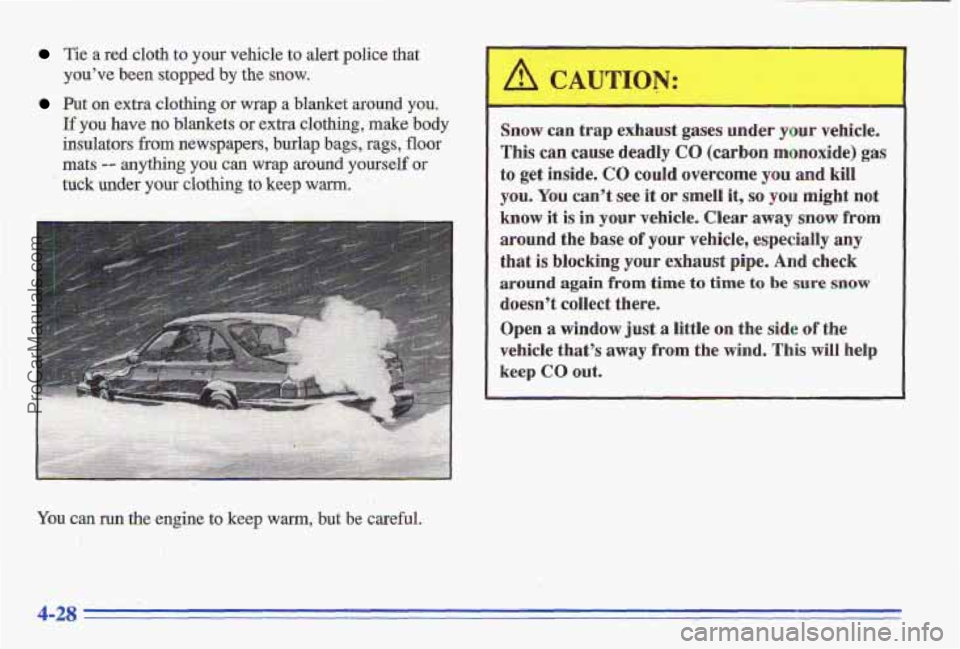
Tie a red cloth to your vehicle to alert police that
you’ve been stopped by the snow.
Put on extra clothing or wrap a blanket around you.
If you have no blankets or extra clothing, make body
insulators
frob newspapers, burlap bags, rags, floor
mats -- anything you can wrap around yourself or
tuck under your clothing to keep warm. ..
Snow can trap exhaust gases under your vehicle.
This
can cause deadly CO (carbon monoxide) gas
to get inside. CO could overcome you and kill
you. You can’t see it or smell it, so you might not
know it is in your vehicle. Clear away snow from
around the base of your vehicle, especially any
that
is blocking your exhaust pipe. And check
around again from time to time to be sure snow
doesn’t collect there.
Open
a window just a little on the side of the
vehicle that’s away from the wind. This will help
keep
CO out.
You can sun the engine to keen warm, but be careful.
1. ..
‘4 . ’% . , ! 1- . ,;
4-28
.. .
ProCarManuals.com
Page 186 of 356
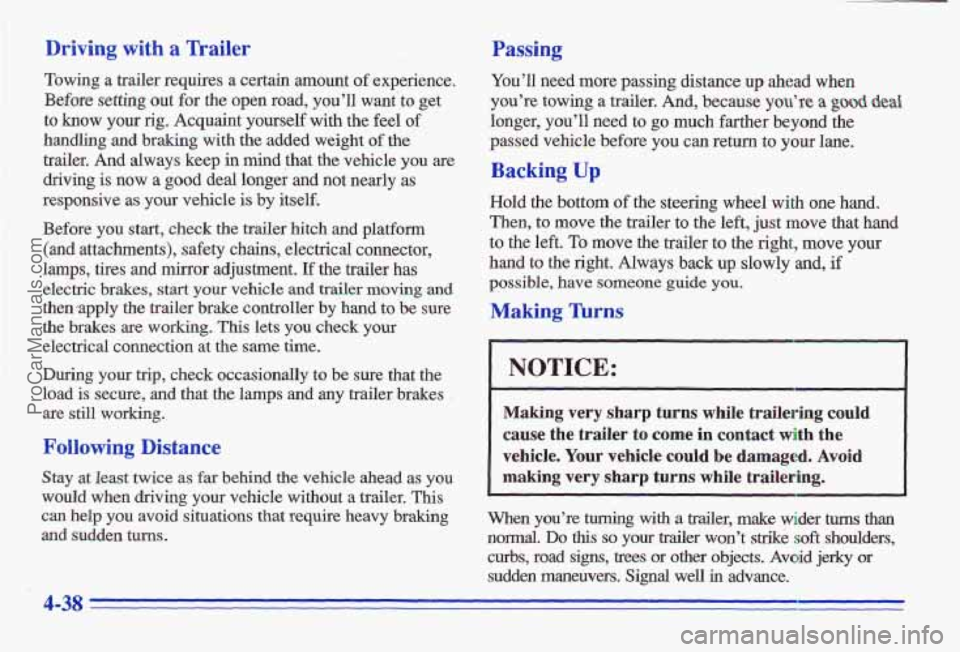
Driving with a Trailer
Towing a trailer requires a certain amount of experience.
Before setting out for the open road, you’ll want’to get
to know your rig. Acquaint yourself with the feel of
handling and braking with the added weight of the
trailer.
And always keep in mind that the vehicle you are
driving is now a good deal longer and not nearly as
responsive as your vehicle is by itselfi.
Before you
start, check the trailer hitch and platform
(and attachments), safety
chains, electrical connector,
lamps, tires and
mirror adjustment, If the trailer has
electric brakes, start your vehicle and trailer moving and
then/apply the trailer brake controller by hand to be sure
the brakes are working. This lets you check your
electrical connection at the
same tirne.
During your trip, check occasionally to be sure that the
load
is secure, and that the lamps and any trailer brakes ,
are still working.
Following Distance
Stay at least twice as far b’ehind the vehicle ahead as you
would when driving your vehicle without a trailer,
This
can help you avoid situations that require heavv braking
and sudden
turns.
Passing
You’ll need more passing distance up ,ahead when
you’re towing a trailer. And, because
you’re a good
longer, you’ll need to go much farther beyond the
passed vehicle before you can return to your lane.
Backing Up
Hold the bottom of the steering wheel with one hand.
Then, to move the trailer to the left, just move that
hand
to the left. To move the trailer to the right, move your
hand to the right. Always back up slowly and, if
possible, have someone guide you.
Making Thrns
I NOTICE:
Making very sharp turns while trailering could
cause th’e trailer to come in contact with the
vehicle. Your vehicle could be damaged. Avoid
making very sharp turns while trailering.
~ ~~ ~~ ~~~
When you’re turning with a trailer, make wider hms than
normal. Do this so your trailer won’t strike soft shoulders,
curbs, road signs, trees or
other objects. Avoid jerky or
sudden maneuvers.
Siggd well in advance.
4-38
ProCarManuals.com
Page 188 of 356
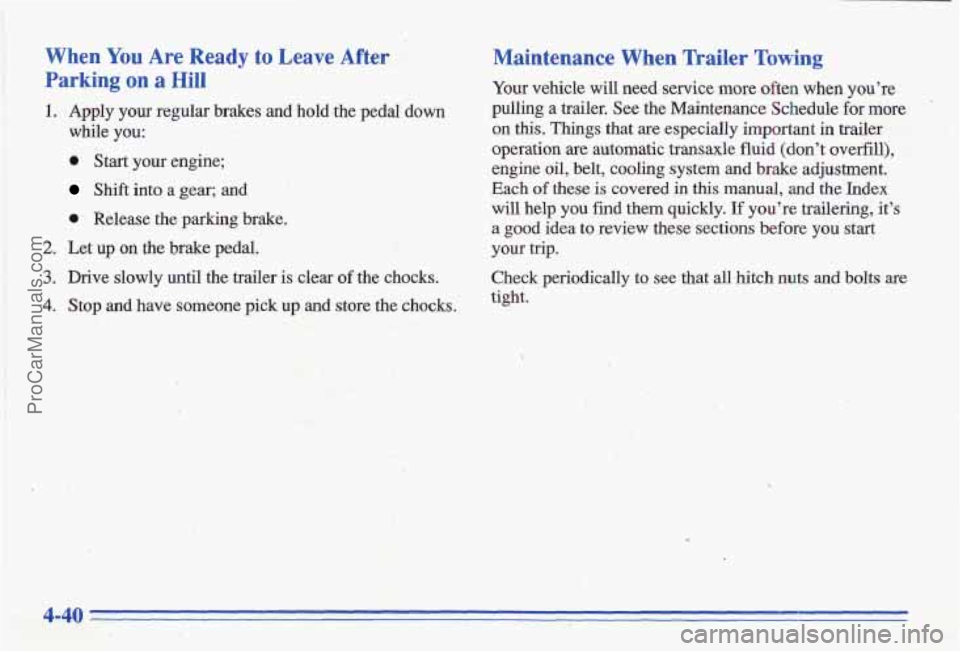
When You Are Ready to Leave After
Parking on a Hill
1. Apply your regular brakes and hold,the pedal down
while
you:
0 Start your engine;
Shift into a gear; and
I. Release the parking brake.
2. Let up on the brake pedal..
3. Drive slowly until the trailer is clear of the chocks.
4. Stop and have someone pick up and store the chocks.
Maintenance When Trailer Towing
Your vehicle will need service more often when you're
pulling a trailer. See the Maintenance Schedule for more
on this. Things that are especially important in trailer
operation are automatic transaxle
fluid (don't ovel-fill),
engine oil, belt, cooling system and brake adjustment.
Each of these is covered in this manual, and the Index
will
help you find them quickly. If you're trailering, it's
a good idea to review these sections before you start
<* ~ I ,,; ;-':'. .a t , ,--: .. ;::l.$.:$ 5
Check periodically to see that all hitch nuts and bolts are
tight.
your trip. ! . .i . :$ ,,- .,,. . . f ~
_I.,
4-40
ProCarManuals.com
Page 211 of 356
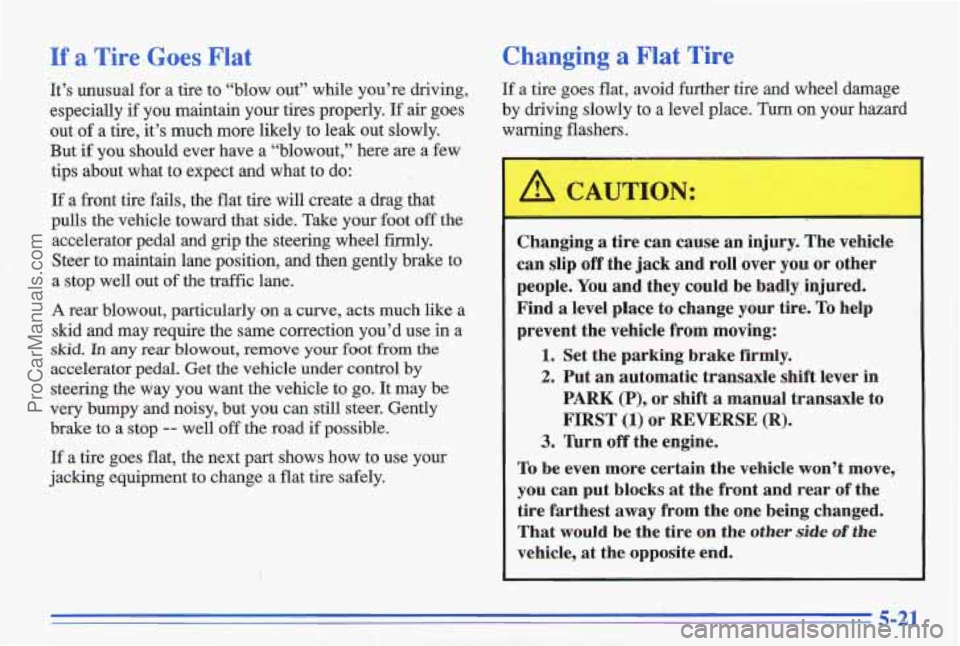
If a Tire Goes Flat
It’s unusual for a tire to “blow out” while you’re \
driving,
especially
if you maintain your tires properly. If air goes
out
of a tire, it’s much more likely to leak out slowly.
But
if you should ever have a “blowout,” here are a few
tips about what to expect and what to
do:
If a front tire fails, the flat tire will create a drag that
pulls the vehicle toward that side. Take your foot off the
accelerator pedal and grip the steering wheel firmly.
Steer
to maintain lane position, and then gently ‘brake to
a stop well out
of the traffic lane.
A rear blowout, particularly on a curve, acts much like a
skid and may require the same correction you’d use in a
skid. In my rear blowout, remove your foot from the
accelerator pedal. Get the vehicle under control by
steering the way you want the vehicle to
go. It may be
very bumpy and noisy, but you can
still steer. Gently
brake to a stop
-- well off the road if possible.
If a tire goes flat, the next part shows how to use your
jacking equipment to change a flat tire safely.
Changing a Flat Tire
If a tire goes flat, avoid further tire and wheel damage
by driving slowly
to a level place. Turn on your hazard
warning flashers.
Changing a tire can cause an injury. The vehicle
can slip
off the jack and roll over you or other
people.
You and they could be badly,injured.
Find
a level place to change your tire. To help
prevent the vehicle from moving:
1. Set the parking brake firmly.
2. Put an’automatic transaxle shift lever in
PARK
(P), or shift a manual transaxle to
FIRST (1) or REVERSE (R).
3. lbrn off the engine.
To be even more certain the vehicle won’t move,
you can put blocks at the front and rear of the
tire farthest away from the one being changed.
That would be the tire
on the other side of the
vehicle, at the opposite end.
5-21
ProCarManuals.com